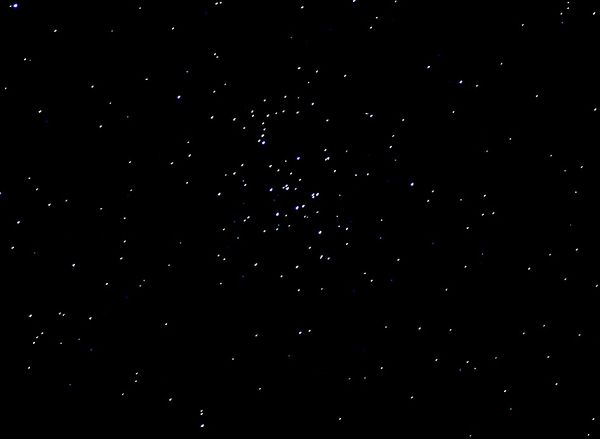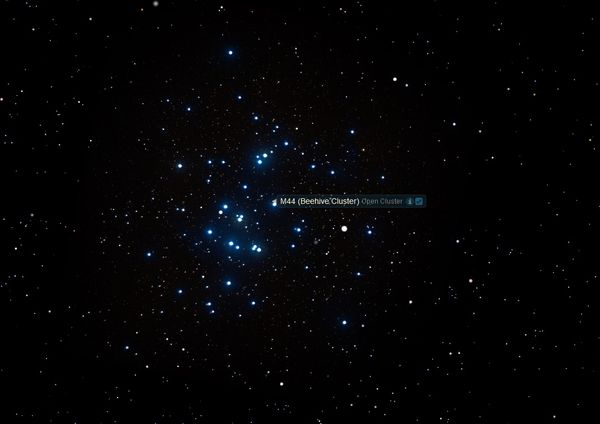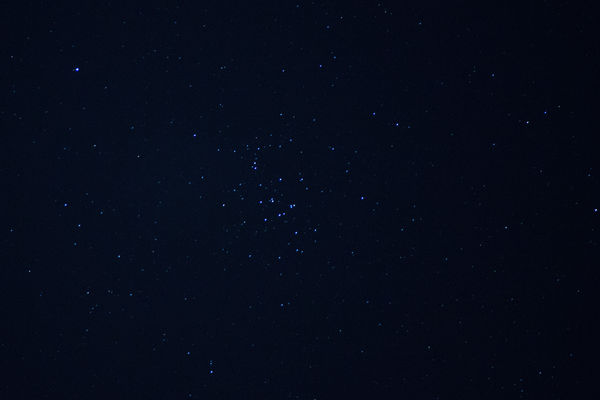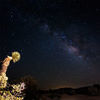A quick way to darken the night sky using Beehive Cluster
Mar 20, 2015 23:51:07 #
I am going to show three images of the Beehive Cluster taken last night with a Sony A99 with a Tokina 300mm F2.8 lens. The shot was taken at ISO 3200. Shutter Time was 2 sec. At F2.8. WB was set to Tungsten.
I didn't set up the equatorial drive. Just took the tripod and camera out. Found that 2 sec was just about too much. The trails are elongated a bit.
Started out in Lightroom and gently lowered the noise level. Then sent it to Photoshop CC. Created a duplicate layer and went to filters/other/highpass. Set the size to 2 pixels. I also took this and ran it through Smart Sharpen, but not sure if it contributed anything. Then went back to the layers and changed the blend mode to hard mix. This greatly darkened the sky. Flattened the layers and returned to Lightroom. Adjust Clarity a bit and highlights and whites which boosted the stars a bit. This is the first picture. It is cropped a bit so as to concentrate on just the Beehive Cluster.
Loaded the same image in the Software package Starry Night Pro and made it about the same size. This is the 2nd picture.
And finally, I am posting the original, only cropped to be about the same size, but nothing else done to it. This is the 3rd picture.
Comparing to Starry Night Pro, the faintest star I can confirm by finding the same star in both images and placing the cursor on it in Starry Night Pro is about magnitude 10.25.
I can see that some stars are very slightly out of alignment, but I suspect that this is rounding errors in Starry Night since they probably limited the resolution of the database.
This shows that a big lens like the Tokina 300mm F2.8 lens can bring in a lot of stars with just a 2 sec exposure. If I use the equatorial mount, I have confirmed stars of 14th magnitude. The point of this is to show that decent astrophotography can be done with just a camera lens.
I didn't set up the equatorial drive. Just took the tripod and camera out. Found that 2 sec was just about too much. The trails are elongated a bit.
Started out in Lightroom and gently lowered the noise level. Then sent it to Photoshop CC. Created a duplicate layer and went to filters/other/highpass. Set the size to 2 pixels. I also took this and ran it through Smart Sharpen, but not sure if it contributed anything. Then went back to the layers and changed the blend mode to hard mix. This greatly darkened the sky. Flattened the layers and returned to Lightroom. Adjust Clarity a bit and highlights and whites which boosted the stars a bit. This is the first picture. It is cropped a bit so as to concentrate on just the Beehive Cluster.
Loaded the same image in the Software package Starry Night Pro and made it about the same size. This is the 2nd picture.
And finally, I am posting the original, only cropped to be about the same size, but nothing else done to it. This is the 3rd picture.
Comparing to Starry Night Pro, the faintest star I can confirm by finding the same star in both images and placing the cursor on it in Starry Night Pro is about magnitude 10.25.
I can see that some stars are very slightly out of alignment, but I suspect that this is rounding errors in Starry Night since they probably limited the resolution of the database.
This shows that a big lens like the Tokina 300mm F2.8 lens can bring in a lot of stars with just a 2 sec exposure. If I use the equatorial mount, I have confirmed stars of 14th magnitude. The point of this is to show that decent astrophotography can be done with just a camera lens.
Processed image using Photoshop

(Download)
Same image using SW Application Starry Night Pro

(Download)
Original (with same crop) but no other adjustments

(Download)
Mar 21, 2015 05:32:20 #
Thanks for the quick tutorial.
The Beehive is such a beautiful sight.
:-)
GT
The Beehive is such a beautiful sight.
:-)
GT
Apr 12, 2015 21:06:52 #
JimH123 wrote:
I am going to show three images of the Beehive Clu... (show quote)
Very well done Jim.
Craig
If you want to reply, then register here. Registration is free and your account is created instantly, so you can post right away.


